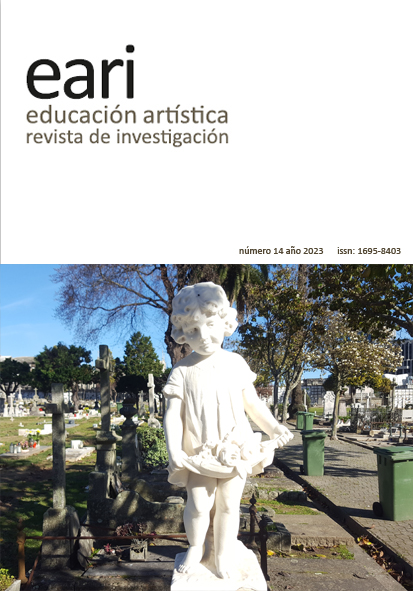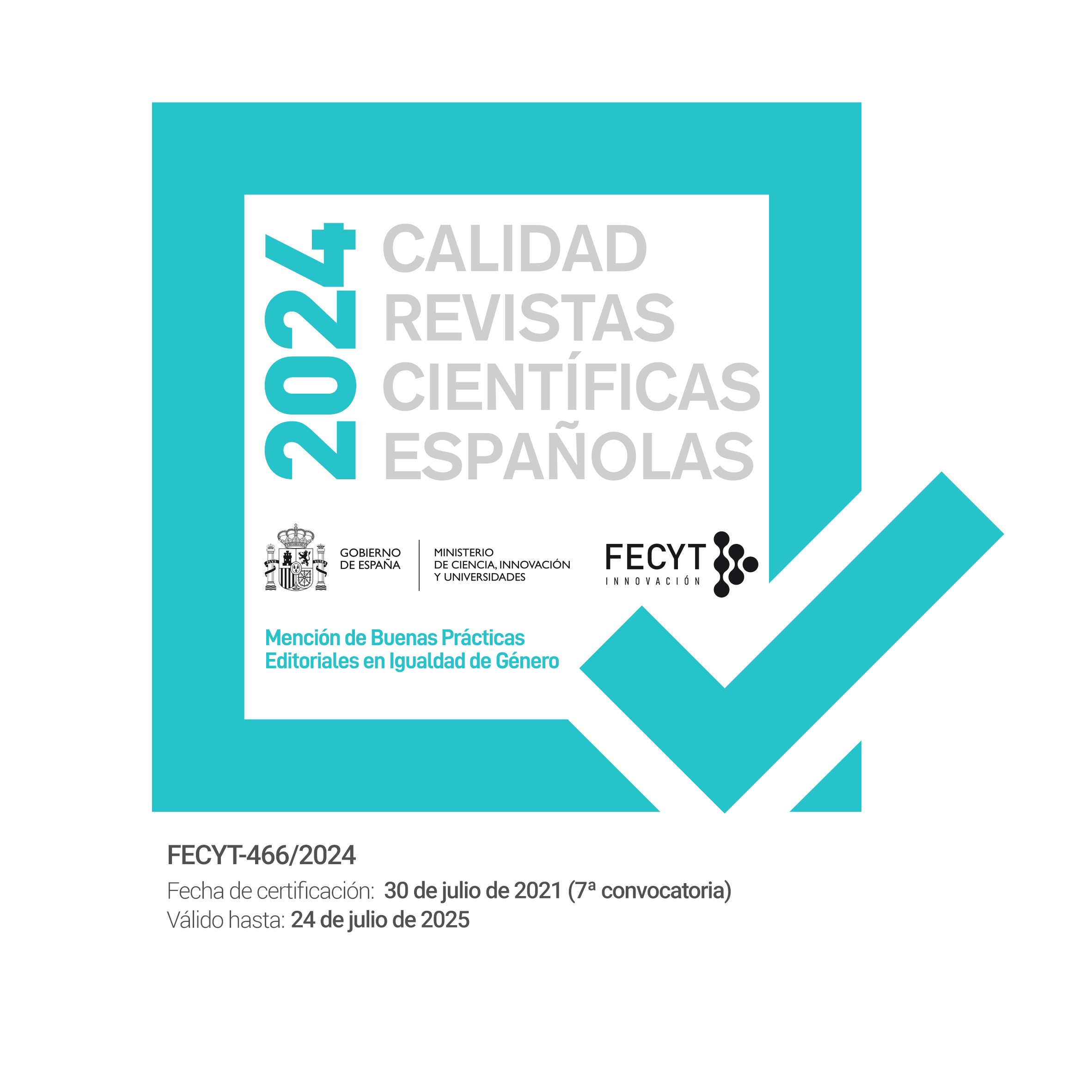Communicating classical mythology through virtual museums: a multimedia experience
DOI:
https://doi.org/10.7203/eari.14.25194Keywords:
teaching, mythology, art museum, learning, cultural exhibition, digitization Abstract
Abstract
The objective of this work is to offer a reflection on the use of digital applications that contribute to the creation of a multimedia knowledge, in particular, to recreate virtual scenarios with the appearance of museum rooms. The aim is to contribute, from teaching, to the approach to artistic manifestations that sink their roots in classical mythology. The final work example has been developed with the Emaze and People art factory applications that combine the use of artistic images and oral expression with brief explanatory audios. To contextualize the working method, the descriptio phase is highlighted, as well as the relevance that underlies the selection of works of art of each exhibition. The character of hypertext, of multilingual narration that acquire the final results is one of the conclusions of these virtual works, because whoever develops the museum can choose the narrative thread to follow. This conjunction highlights the importance of creative and communicative skills developed by learners, as well as emotional competence. Finally, it is concluded that the motivating nature of this practice contributes to the good learning of Classical Culture by bringing its participants to the functions of the role of exhibition curator, allowing them to observe classical mythology from multiple personal perspectives thus contributing to the integral formation of the disciple.
 Downloads
Downloads
 References
References
Albarrán, A. (8 de abril de 2014). La transmisividad en la docencia: alternativas para una educación más democrática. https://laimprentadefreinet.wordpress.com/2014/04/08/transmisividad-en-la-docencia-y-sus-alternativas/ [Fecha de consulta 01/10/2023]
Ariza, M. & Naz, A. (2016). La creación del Museo Virtual del Patrimonio del IES “Pedro Espinosa”: una tarea de todos. Cabás: Revista del Centro de Recursos, Interpretación y Estudios en materia educativa (CRIEME) de la Consejería de Educación, Cultura y Deporte del Gobierno de Cantabria (España), 16, 82-108. http://revista.muesca.es/articulos16/379-la-creacion-del-museo-virtual-del-patrimonio-del-ies-pedro-espinosa-una-tarea-de-todos [Fecha de consulta 01/10/2023]
Ballester, R. & Cárceles, P. (2013). People Art Factory. [Aplicación web]. https://peopleartfactory.com/
Bogenn, T., Sims, K., Owen, M., & Prima, G. (2018). Assassin’s creed odyssey [videojuego]. Prima Games.
Brocky, K. (1853 ca.). Ceres and Triptolemos [óleo sobre madrea]. Miskolc: Ottó Herman Museum.
Columbus, C. (Director). (2010). Percy Jackson y el ladrón del rayo [Película]. Zinder.
Costa, L. (1500-1530). El Argo [témpera sobre tabla]. Padua : Museo Cívico.
Chaguaceda, C. & Guilarte, C. (2019). Comisariar la institución: reflexiones sobre comunicación, arte, museos e impacto. Boletín de la ANABAD, 69(4), 349-361.
Domingo, S. (2020). El viaje de las emociones a través del Arte. [Trabajo fin de grado]. Universidad de Zaragoza.
Elsheimer, A. (1609-1610). Jupiter und Merkur bei Philemon und Baucis [óleo sobre cobre]. Dresde: Staatliche Kunstsammlungen Dresden.
Elvira Barba, M. A. (2008). Arte y Mito. Manual de iconografía clásica. Editorial Silonia.
Freudenthal, Th. (Director). (2013). Percy Jackson y el mar de los monstruos [Película].Trireme Productions.
García Gual, C. (2002). Relato mítico y momento pictórico: Rubens y Ovidio. En VV. AA. Historias inmortales (pp. 281-198). Galaxia Guttenberg.
Garnica, A. (2019). La descriptio como recurso educativo. Thamyris, nova series Revista de Didáctica de Cultura Clásica, Griego y Latín, 10, 17–42.
Gossaert, J. (1520). Las metamorfosis de Hermafrodito y Salmacis [tabla]. Róterdam : Museo Boijmans Van Beuningen.
Grimal, P. (2004). Diccionario de la mitología griega y romana. [Trad. F. Payarols]. Editorial Paidós.
Guarino Ortega, R. (2008). La mitología clásica en el arte. Universidad de Murcia.
Jiménez Alcázar, J. F. (2015). Cambio de época versus época de cambios. Medievalistas y nuevas tecnologías. En A. Vanina Neyra y G. Fabián Rodríguez (Eds.), ¿Qué implica ser medievalista? Prácticas y reflexiones en torno al oficio del historiador: Vol. 1 El Medioevo Europeo (pp. 39-52). Mar del Plata: Universidad Nacional de Mar del Plata.
Lagreneé, L. J. F. (1769). La moisson, ou Cérès et Triptolème [óleo sobre lienzo]. Versalles: Musée National du Château.
Leterrier, L. (Director). (2010). Furia de titanes [Película]. Legendary Pictures.
Liebesman, J. (Director). (2012). Ira de titanes [Película]. Legendary Pictures.
Martín-Laborda, R. (2005). Las nuevas tecnologías en la educación. Fundación Auna.
Martínez García, Mª. A. (2009). El nuevo espacio interactivo. Confluencias entre la literatura y el multimedia. Siranda. Revista de Estudios Culturales, Teoría de los Medios e Innovación Tecnológica, 2, 114-148.
Muret, P. (Director). (2006) For this is my body [Película]. SRG SSR, Radio Televisión Suiza.
Nisani, M., Schwartz, Sh. & Livshin, A. (2009). Emaze [Aplicación web multiplataforma] Visual Software Systems Ltd. https://www.emaze.com/
Panozzo, A. (2013). El ser virtual. El museo virtual. El Museo de Arte de Uruguay, MUVA. AACA Digital. Revista de la asociación aragonesa de críticos de arte, 24, (6 pág.).
Pascual A. & Septién, R. (2013). Destripando la historia [Canal]. Youtube. https://www.youtube.com/user/rodrigoseptienprod/featured [Fecha de consulta 01/10/2023].
Pérez-Valle, A., Aguirrezabal, P. & Sillaurren, S. (2014). Playhist: Play and Learn History. Learning with a Historical Game vs An Interactive Film. En M. Ioannides, N. Magnenat-Thalmann, E. Fink, R. Žarnić, A. Y. Yen & E. Quak (Eds), Digital Heritage. Progress in Cultural Heritage: Documentation, Preservation, and Protection. Lecture Notes in Computer Science, 8740, (pp. 546-554). Springer, Cham. https://doi.org/10.1007/978-3-319-13695-0_54
Prensky, M. (2001). Nativos digitales, inmigrantes digitales. On the Horizon, 9, 6. MCB University Press. [Trad. Julia Molano en https://www.google.es/url?sa=t&rct=j&q=&esrc=s&source=web&cd=&cad=rja&uact=8&ved=2ahUKEwj1puqf5dSBAxXMVaQEHSw5CvEQFnoECBEQAQ&url=https%3A%2F%2Faprenderapensar.net%2Fwp-content%2Fuploads%2F2010%2F10%2FNativos-digitales-parte1.pdf&usg=AOvVaw3oalQY5O_Jil-Qg7DCUkDk&opi=89978449 [Fecha de consulta 01/10/2023].
Reche, A. (2019). Quimera [CD, formato digital]. Universal Music Group.
Rembrandt (1658). Filemón y Baucis [óleo sobre lienzo]. Washington DC: Galería Nacional de Arte.
Reni, G. (1620-1625). Atalanta e Hipómenes [óleo sobre lienzo]. Madrid : Museo del Prado y Nápoles: Museo Capodimonte.
Restout, J. B. (1769). Philemon and Baucis giving hospitality to Jupiter and Mercury [óleo sobre tela]. Tours: Musée des beaux-arts de Tours.
Roberti, E. de’ (1480 ca.). Los Argonautas abandonan la Cólquida [óleo sobre tabla]. Madrid : Museo Thyssen-Bornemisza.
Robles, E. (2015). Una experiencia en el aula: repercusión de la mitología grecolatina y el museo del Prado. Thamyris, nova series Revista de Didáctica de Cultura Clásica, griego y latín, 6, 399-422. http://www.thamyris.uma.es/Thamyris6/ROBLES.pdf [Fecha de consulta 01/10/2023].
Rubens, P. P. (1620 ca.). Paisaje con Filemón y Baucis [óleo sobre lienzo]. Viena: Museo de Historia del Arte de Viena.
Ruiz, W., Córdoba, H. & Zipa, O. L. (2019). La investigación-creación, generador de conocimiento para la construcción de un museo virtual del patrimonio científico y cultural del Dr. Jorge Reynolds Pombo. Calle 14. Revista de investigación en el campo del arte, 14(25), 206–223. https://doi.org/10.14483/21450706.14077
Santibáñez-Velilla, J. (2006). Virtual museums as a teaching and learning tool. [Los museos virtuales como recurso de enseñanza-aprendizaje]. Comunicar, 27, 155-162. https://doi.org/10.3916/C27-2006-24
Torres Vargas, G. A. (2003). El concepto de biblioteca virtual y su relación con el acceso universal a los documentos. [Tesis UCM]. Universidad Complutense de Madrid. https://eprints.ucm.es/id/eprint/3815/ [Fecha de consulta 01/10/2023].
Volonakis, K. (fecha incierta). Argo [óleo sobre tabla]. Colección privada.
Waterhouse, J. W. (1898). Ariadne [óleo sobre lienzo] Colección privada.
Zapatero, D. (2011). Virtual 3D (Mupai Virtual 3D). Arte, individuo y sociedad, 23(1), 73-79.
Downloads
Published
How to Cite
-
Abstract519
-
PDF (Español)431
Issue
Section
License
![]()
Educación artística: revista de investigación (EARI) retains the proprietary rights (copyright) of published works, and favors and allows the reuse of the same under the license Creative Commons Attribution-Noncommercial Use 4.0 International License (CC-BY-NC 4.0), which allows third parties to use the published material whenever the authorship of the work and the source of publication is mentioned (journal, publisher and URL of the work), and it is used for non-commercial purposes.
Authors are encouraged to disseminate their work after it has been published, through the internet (for example, in institutional archives online or on its website) which can generate interesting exchanges and increase work appointments.








